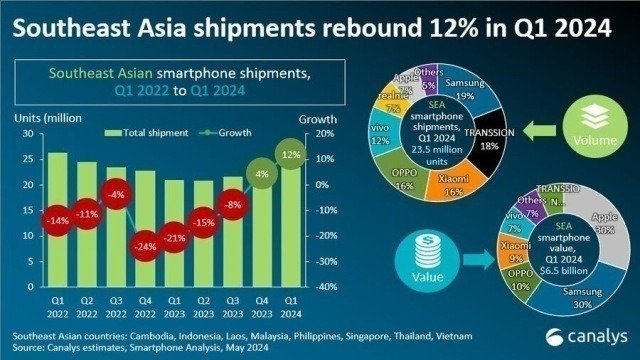According to Canalys’ research, the Southeast Asia smartphone market experienced a 12 percent year-on-year growth in Q1 2024, reaching 23.5 million units. The growth in the Southeast Asia smartphone market signifies a recovery from the challenging macroeconomic conditions of 2023, although shipments remain below pre-2023 levels.
 Q1 2024 Growth Drivers
Q1 2024 Growth Drivers
Smartphone manufacturers capitalized on healthier channel inventories and improving consumer sentiment in the Southeast Asia smartphone market to drive growth in Q1 2024.
Efforts by smartphone vendors in late 2023 to normalize channel inventory paid off, with sales channels better positioned to take in more sell-in.
Samsung maintained its lead in Southeast Asia with a 19 percent market share, despite a 20 percent decline in volume. The decline in volume is expected, considering Samsung’s product strategy prioritizes expanding its mid-high segments, including the Galaxy S and the A5x and A3x categories. Future growth is anticipated to stem from the premium segment due to this strategic shift,” Sheng Win Chow, Analyst at Canalys, said.
TRANSSION secured second place with an 18 percent market share and an impressive 197 percent year-on-year growth. Its co-branding and partnerships with mobile gaming companies during Ramadan resonated with the region’s young demographics. By offering affordable, high-performance gaming devices, TRANSSION successfully appealed to this market segment.

Xiaomi and OPPO each held a 16 percent market share in the region.
Xiaomi grew by 52 percent year-on-year, driven by a competitive product mix, including entry-level models like the Redmi Ax and Cx series and strong mid-range options from the Note series in the Southeast Asia smartphone market.
In contrast, OPPO saw a 5 percent decline.
Vivo captured a 12 percent market share, shipping 2.8 million units and growing 12 percent year-on-year, focusing on expanding its mid-high-end segment through the Y100 and V-series in the Southeast Asia smartphone market.
Price-sensitive markets like Indonesia and the Philippines witnessed a revival in the sub-US$100 price segment.
Increasingly affordable devices with high core specs enable customers to upgrade at a lower price. TRANSSION’s success in the Philippines is largely attributed to differentiating similarly priced devices across its sub-brands Infinix, Tecno, and iTel.
In Thailand, Malaysia, and Vietnam, Samsung led the market in Q1 2024, bolstered by the launch of the Galaxy S24. Samsung’s premiumization strategy, supported by premium channels like branded experience stores and telco channels, helped drive flagship sales.
Future Outlook
Canalys predicts that smartphone shipments in Southeast Asia will grow by 4 percent in 2024. Most vendors are cautious about expecting a large external sales boost from a natural refresh cycle. Though the Southeast Asia smartphone market rebounded by 12 percent in Q1 2024, most growth occurred in price-sensitive markets like Indonesia and the Philippines. Vendors with optimized supply chains and operational efficiency will be best positioned to succeed.
The long-term outlook for the Southeast Asian market remains positive, driven by a young population and increasingly democratized digital financial services. Tim Cook’s recent visit to Singapore and Indonesia highlights Apple’s commitment and interest in the region.
